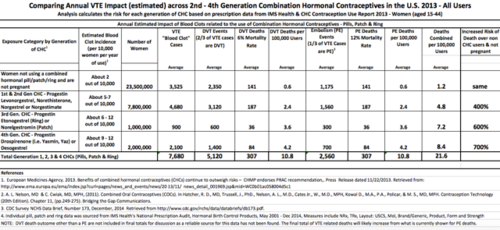We never expected that a simple decision, one that thousands of women make every day, would change our lives forever. The decision that our daughter made to use the NuvaRing as birth control seemed reasonable–it is a convenient method used by many women. If only we knew then what we knew now.
When the Crisis Started
It was Friday night like any other except that our 2 oldest daughters, Ashley (24) and Brittany (23) who graduated from Chico State the previous year, were driving up to visit their younger sister, Morgan (21) who was in her junior year at Chico State. The past 4 years my daughters shared the best of times together at Chico State. They were neighbors, played intramural sports together, volunteered together, attended adventure outings, shared friends, rode miles in Bidwell Park, shared clothes and simply hung out together as sisters do.
It was 12:30 a.m. on December 1, 2012 when my wife and I were awoken by 2 simultaneous phone calls. The first call came from our youngest daughter Morgan to my wife’s (Dana) cell phone which she keeps at her bedside every night. The 2nd call came to me from our eldest daughter Ashley to my cell phone. When my wife’s phone rang, she stepped out of our bedroom to take the call and I immediately could tell that something terrible had occurred. Ashley told me that she was calling from the hospital and that Brittany has been taken by ambulance to the emergency room after she her head rolled back suddenly and she stopped breathing at Morgan’s house.
We immediately threw some clothes on and left for Chico which is normally a 3 hour drive. I called the hospital and they said that they would have the head nurse in charge of the Neuro ICU call back as soon as she was able to give us an overview of Brittany’s situation.
I called Ashley and she explained that the 3 of them had gone out for the evening as planned even though Brittany was not feeling 100%. While they were out, Brittany was feeling “anxious” and said that she felt like her heart was racing, but she wasn’t sure if she wanted to go home or not because we suspect she didn’t want to disappoint Morgan by leaving early. Brittany then commented that the music was too loud so they decided they better go back to Morgan’s house so Brittany could relax. When they arrived back at Morgan’s’ house, Brittany sat on the couch while she drank a glass of water and ate a snack in hopes that she would relax and begin to feel better. Ashley and Morgan were sitting on either side of Brittany in an effort to help her feel at ease. A few minutes later Brittany’s head went back and she started gurgling and stopped breathing.
Ashley called 911 immediately and began to administer CPR to Brittany. The paramedics were dispatched and got there within minutes. When they arrived, Brittany was still not breathing so they continued CPR and used paddles to deliver electric shock a number of times with no luck. They inserted a breathing tube and then transferred Brittany to Enloe Medical Center where she was revived.
Ashley said that the nurse told her this was very serious and that we needed to get there ASAP. I assured her we would be up there as fast as my car would go. After hanging up with Ashley, we drove in silence for the next few minutes until my phone rang again. My heart sank as I realized that Brittany had been without oxygen for more than a few minutes, and while I didn’t know how long the brain could go without oxygen, I had a real bad feeling about this. I gave Dana a summary of the conversation that I had with Ashley and we drove in silence for the next few minutes until my phone rang again.
It was the head nurse from the Neuro Trauma Unit and she explained that Brittany had arrived at the hospital after suffering sudden cardiac arrest as well as respiratory failure with pulmonary hemorrhaging and was now in a coma in critical condition. She said that it was not clear how long Brittany had gone without oxygen before they were finally able to resuscitate her. The nurse made it very clear to us that this was very serious and that we needed to get to the hospital as soon as possible. For the next 2 hours we raced to the hospital in complete silence.
Trying To Figure Out What Was Wrong
When we arrived at the hospital, the Neuro ICU was full of Doctors and Nurses actively trying to save Brittany’s life. My poor daughters, Ashley and Morgan were completely traumatized by what they had just experienced with their sister. Then we met with a team of doctors that were struggling to understand why a perfectly healthy 23 year old woman could arrive at the hospital in her condition. They ask a series of questions like, does she smoke, do drugs, take prescription drugs, vitamins, herbs etc. Our answers were “no” just like her sisters had told them. About a couple hours later Dana remembered that she was on birth control, called NuvaRing. It’s seems like it’s a class all to itself…birth control…but it’s really a prescription drug. None of us thought anything of it at the time as Ashley and Morgan were also using the NuvaRing contraceptive device.
Toxicology reports came back immediately and were all negative. Over 40 blood tests were initiated to determine if Brittany had an autoimmune blood condition such as vasculitis or lupus that might be causing the pulmonary hemorrhaging. A number of these tests would take up to a week to come back, so a process called plasmapheresis was started in order to filter Brittany’s blood of any autoimmune cells that may have caused Brittany to hemorrhage. This process is similar to dialysis.
The First Hint Of A Blood Clot
As part of the preparation for the plasmapheresis process, a doctor attempted to insert a line into a deep vein in Brittany’s right leg, but he was unable to get it to feed into the vein due to a massive blood clot that was discovered. This was the first indication that the blood clot may be the root of a series of cascading events that led to Brittany’s condition. The doctors immediately removed the NuvaRing as they said it was likely related to the extensive deep vein thrombosis (DVT) in her right leg.
Once the blood clot was detected, the doctors suspected that a condition called Disseminated Intravascular Coagulation (DIC) had taken place. DIC is a condition that presents itself when the consumption and subsequent exhaustion of clotting proteins (soldiers in our blood that help the blood to clot) causes bleeding in other areas of the body. With Brittany, the clotting proteins were “used up” by the DVT in her leg which likely left the rest of the body depleted of the necessary clotting factors required to stop the bleeding in her lungs. In some cases like Brittany’s, the doctors explained that bleeding simply starts on its own without any injury due to how “thin” the blood becomes.
The doctors suspect the DIC event triggered the cascading effects which in turn lead to an acute onset Diffuse Alveolar Hemorrhage (DAH) causing blood to collect within the alveoli in her lungs. We were told that Brittany’s blood likely became so thin that it caused the blood cells surrounding her lungs to actually leak into her lungs and flood the alveoli. The alveoli are part of the lungs that are responsible for the exchange of oxygen in our lungs. These alveoli inflate and deflate with inhalation and exhalation. If enough alveoli are affected, gas exchange is disrupted and the brain is starved of oxygen.
The Fatal Consequences Of the Blood Clot
Here is a summary of the cascading events that we understand lead to Brittany’s death.
1. DVT – A large blood clot developed in a deep vein in her leg, which we believe was caused by the NuvaRing.
2. DIC – Disseminated Intravascular Coagulation. This condition occurs when the consumption and subsequent exhaustion of clotting proteins (soldiers in our blood that help the blood to clot) induces severe bleeding in other areas of the body. With Brittany, the clotting proteins were “used up” by the DVT in her leg which likely left the rest of the body depleted of the necessary clotting factors required to stop the bleeding in her lungs.
3. DAH – Diffuse Alveolar Hemorrhage. Blood began to weep into her lungs and into the clusters of alveoli which look like individual grapes in a bunch. The individual alveoli are tightly wrapped in blood vessels, and it is here that oxygen exchange occurs. When the blood leaked into the alveoli, her lungs began to fill up with blood instead of exchanging oxygen. Normally the oxygen-rich blood returning to her heart via the pulmonary veins is pumped back into systemic circulation. Unfortunately, the amount of oxygen flow diminished rapidly, effectively starving Brittany’s heart and brain from oxygen. This correlates with the “anxious” feelings that Brittany was describing to her sisters and her boyfriend. Her brain was not receiving enough oxygen, so it signaled her heart to beat faster and faster until she reached hypoxemic respiratory failure, had a heart attack, and lost consciousness.
4. This is when Brittany’s life began to quickly slip away. Unfortunately, the brain cannot survive more than 3 to 5 minutes without oxygen before brain damage begins. A scan of Brittany’s brain was done right after she arrived at the hospital and the initial results did not indicate any sign of brain damage, but the neurologist warned us that the results of hypoxia (lack of oxygen to the brain) don’t typically show up within the first 24 hours.
Over the next 2 days, the neurologist conducted a series of extensive neurological evaluations on Brittany to determine the extent of brain damage that had occurred. I watched each of these tests hoping for a sign of life, but instead, I felt like I watched her die over and over again. These testes were extremely painful to watch as the reality sank in that Brittany’s brain was seriously damaged. No parent should ever have to witness these tests, but I could not give up hope, so I watched until I my heart could take no more. Eventually I could no longer witness these tests. I will live with these horrific memories the rest of my life.
The doctor was preparing us for the worst case scenario which turned out to be true. Brittany had irreversible brain damage, and a final CT scan indicated brain death. He ordered a second opinion and the results were consistent with the first. We arranged for a 3rd opinion and held out hope as we were desperate to save her life. Our entire family was with us and we all prayed for a miracle, but unfortunately, our prayers were not answered. Our beautiful, healthy, sweet, responsible, funny and loving Brittany was gone forever…and there wasn’t anything I could do for her or for my other precious daughters.
Her death diagnosis was acute respiratory failure, diffuse pulmonary hemorrhage, diffuse venous thromboembolism with deep venous thrombosis, severe anoxic brain damage. We believe the blood clot (DVT) which was caused by the NuvaRing is the true cause of death. Without the clot, none of the events that followed would have occurred.
All of the tests that were conducted to determine if Brittany had some sort of an autoimmune blood condition came back negative, so this solidified our theory that the NuvaRing caused Brittany’s death.
True to form, Brittany continued her life journey of compassion all the way to the end. Five people around the nation were blessed with Brittany’s greatest gift of all…her vital organs. Her lungs are now breathing fresh air in North Carolina; her heart is beating strong in Texas and her kidneys, liver and pancreas were early Christmas presents to patients throughout the Bay Area.
Brittany was on the NuvaRing for 2 1/2 years and had just inserted a new ring the day before she stopped breathing. Brittany and all of us who loved her are now robbed of what could have been.
We have formed a parent group to help educate women on the serious and real side effects of the NuvaRing birth control device and help share the information they need to make a more informed decision based on a combination of safety, efficacy and convenience. Not a week goes by without being contacted by a young woman or a parent whose lives have been seriously impacted by a death or near death due to what they believe was a side effect of the NuvaRing.
How many young women have to die in order for something to be done?
Real Risk Study: Birth Control and Blood Clots
Lucine Health Sciences and Hormones Matter are conducting research to investigate the relationship between hormonal birth control and blood clots. If you or a loved one have suffered from a blood clot while using hormonal birth control, please consider participating. We are also looking for participants who have been using hormonal birth control for at least one year and have NOT had a blood clot, as well as women who have NEVER used hormonal birth control. For more information or to participate, click here.
















